start stop button KIA CADENZA 2020 Owners Manual
[x] Cancel search | Manufacturer: KIA, Model Year: 2020, Model line: CADENZA, Model: KIA CADENZA 2020Pages: 560, PDF Size: 11.37 MB
Page 15 of 560
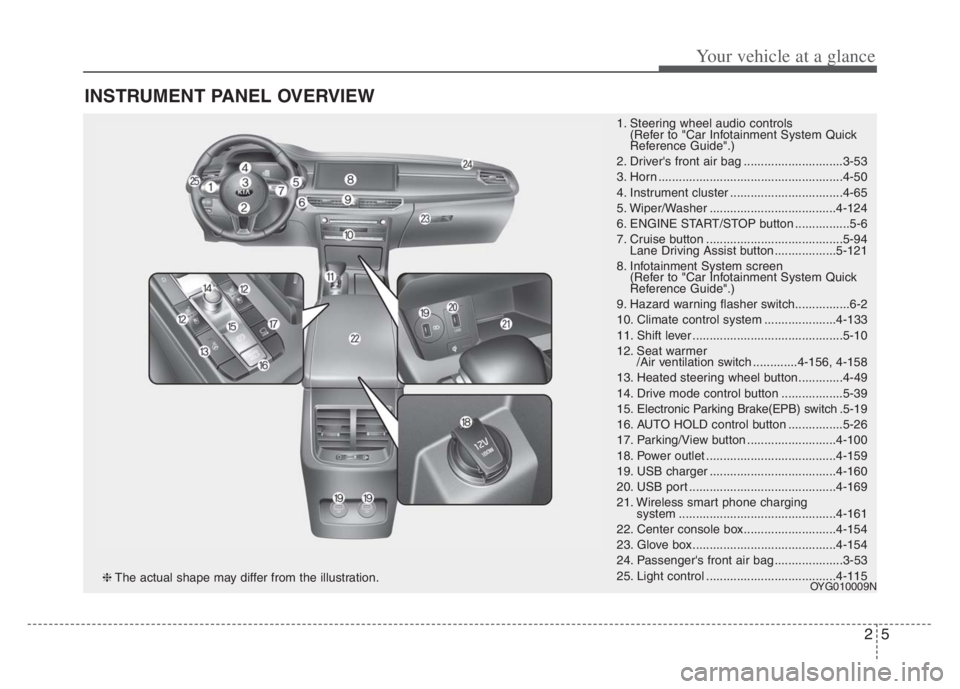
25
Your vehicle at a glance
INSTRUMENT PANEL OVERVIEW
1. Steering wheel audio controls
(Refer to "Car Infotainment System Quick
Reference Guide".)
2. Driver's front air bag .............................3-53
3. Horn ......................................................4-50
4. Instrument cluster .................................4-65
5. Wiper/Washer .....................................4-124
6. ENGINE START/STOP button ................5-6
7. Cruise button ........................................5-94
Lane Driving Assist button..................5-121
8. Infotainment System screen
(Refer to "Car Infotainment System Quick
Reference Guide".)
9. Hazard warning flasher switch................6-2
10. Climate control system .....................4-133
11. Shift lever ............................................5-10
12. Seat warmer
/Air ventilation switch .............4-156, 4-158
13. Heated steering wheel button.............4-49
14. Drive mode control button ..................5-39
15. Electronic Parking Brake(EPB) switch.5-19
16. AUTO HOLD control button ................5-26
17. Parking/View button ..........................4-100
18. Power outlet ......................................4-159
19. USB charger .....................................4-160
20. USB port ...........................................4-169
21. Wireless smart phone charging
system ..............................................4-161
22. Center console box...........................4-154
23. Glove box ..........................................4-154
24. Passenger's front air bag ....................3-53
25. Light control ......................................4-115
OYG010009N❈The actual shape may differ from the illustration.
Page 27 of 560
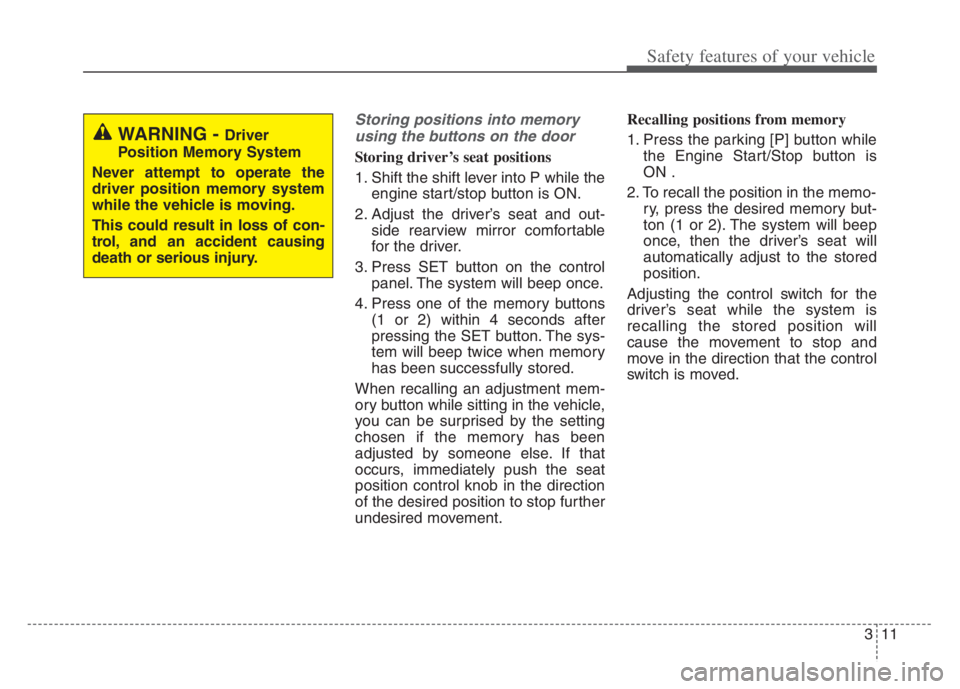
311
Safety features of your vehicle
Storing positions into memory
using the buttons on the door
Storing driver’s seat positions
1. Shift the shift lever into P while the
engine start/stop button is ON.
2. Adjust the driver’s seat and out-
side rearview mirror comfortable
for the driver.
3. Press SET button on the control
panel. The system will beep once.
4. Press one of the memory buttons
(1 or 2) within 4 seconds after
pressing the SET button. The sys-
tem will beep twice when memory
has been successfully stored.
When recalling an adjustment mem-
ory button while sitting in the vehicle,
you can be surprised by the setting
chosen if the memory has been
adjusted by someone else. If that
occurs, immediately push the seat
position control knob in the direction
of the desired position to stop further
undesired movement.Recalling positions from memory
1. Press the parking [P] button while
the Engine Start/Stop button is
ON .
2. To recall the position in the memo-
ry, press the desired memory but-
ton (1 or 2). The system will beep
once, then the driver’s seat will
automatically adjust to the stored
position.
Adjusting the control switch for the
driver’s seat while the system is
recalling the stored position will
cause the movement to stop and
move in the direction that the control
switch is moved.
WARNING - Driver
Position Memory System
Never attempt to operate the
driver position memory system
while the vehicle is moving.
This could result in loss of con-
trol, and an accident causing
death or serious injury.
Page 28 of 560
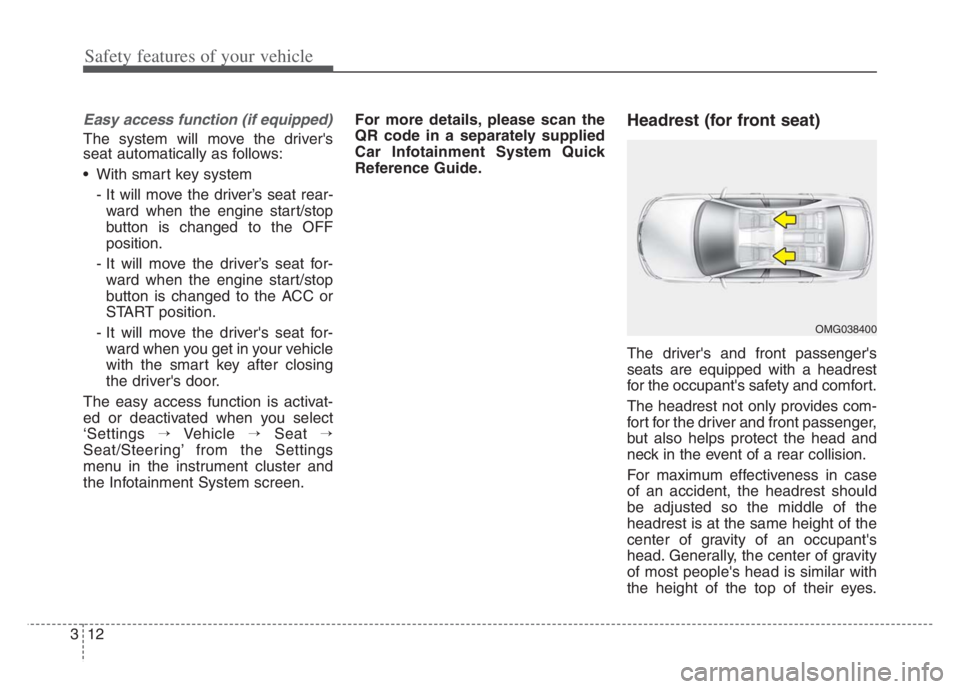
Safety features of your vehicle
12 3
Easy access function (if equipped)
The system will move the driver's
seat automatically as follows:
With smart key system
- It will move the driver’s seat rear-
ward when the engine start/stop
button is changed to the OFF
position.
- It will move the driver’s seat for-
ward when the engine start/stop
button is changed to the ACC or
START position.
- It will move the driver's seat for-
ward when you get in your vehicle
with the smart key after closing
the driver's door.
The easy access function is activat-
ed or deactivated when you select
‘Settings →Vehicle →Seat →
Seat/Steering’ from the Settings
menu in the instrument cluster and
the Infotainment System screen.For more details, please scan the
QR code in a separately supplied
Car Infotainment System Quick
Reference Guide.
Headrest (for front seat)
The driver's and front passenger's
seats are equipped with a headrest
for the occupant's safety and comfort.
The headrest not only provides com-
fort for the driver and front passenger,
but also helps protect the head and
neck in the event of a rear collision.
For maximum effectiveness in case
of an accident, the headrest should
be adjusted so the middle of the
headrest is at the same height of the
center of gravity of an occupant's
head. Generally, the center of gravity
of most people's head is similar with
the height of the top of their eyes.
OMG038400
Page 36 of 560
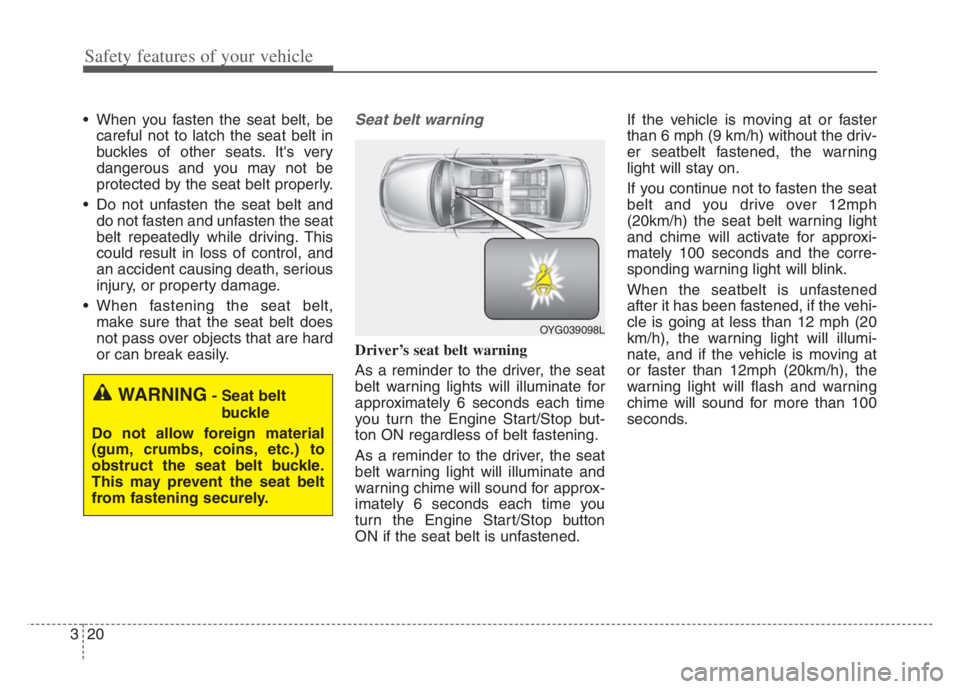
Safety features of your vehicle
20 3
When you fasten the seat belt, be
careful not to latch the seat belt in
buckles of other seats. It's very
dangerous and you may not be
protected by the seat belt properly.
Do not unfasten the seat belt and
do not fasten and unfasten the seat
belt repeatedly while driving. This
could result in loss of control, and
an accident causing death, serious
injury, or property damage.
When fastening the seat belt,
make sure that the seat belt does
not pass over objects that are hard
or can break easily.Seat belt warning
Driver’s seat belt warning
As a reminder to the driver, the seat
belt warning lights will illuminate for
approximately 6 seconds each time
you turn the Engine Start/Stop but-
ton ON regardless of belt fastening.
As a reminder to the driver, the seat
belt warning light will illuminate and
warning chime will sound for approx-
imately 6 seconds each time you
turn the Engine Start/Stop button
ON if the seat belt is unfastened.If the vehicle is moving at or faster
than 6 mph (9 km/h) without the driv-
er seatbelt fastened, the warning
light will stay on.
If you continue not to fasten the seat
belt and you drive over 12mph
(20km/h) the seat belt warning light
and chime will activate for approxi-
mately 100 seconds and the corre-
sponding warning light will blink.
When the seatbelt is unfastened
after it has been fastened, if the vehi-
cle is going at less than 12 mph (20
km/h), the warning light will illumi-
nate, and if the vehicle is moving at
or faster than 12mph (20km/h), the
warning light will flash and warning
chime will sound for more than 100
seconds.
WARNING- Seat belt
buckle
Do not allow foreign material
(gum, crumbs, coins, etc.) to
obstruct the seat belt buckle.
This may prevent the seat belt
from fastening securely.
OYG039098L
Page 37 of 560
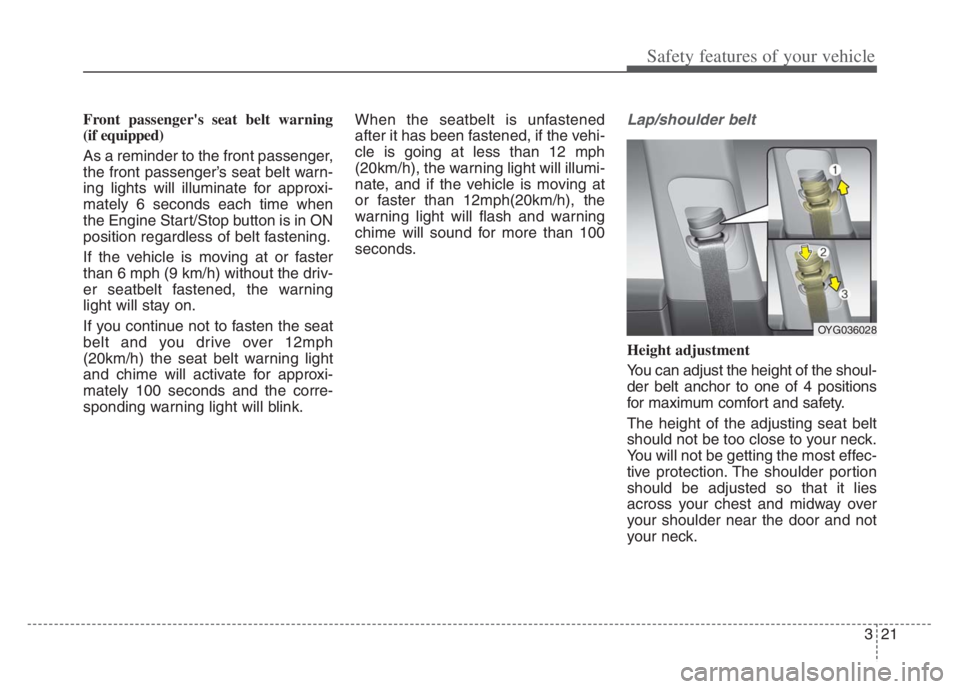
321
Safety features of your vehicle
Front passenger's seat belt warning
(if equipped)
As a reminder to the front passenger,
the front passenger’s seat belt warn-
ing lights will illuminate for approxi-
mately 6 seconds each time when
the Engine Start/Stop button is in ON
position regardless of belt fastening.
If the vehicle is moving at or faster
than 6 mph (9 km/h) without the driv-
er seatbelt fastened, the warning
light will stay on.
If you continue not to fasten the seat
belt and you drive over 12mph
(20km/h) the seat belt warning light
and chime will activate for approxi-
mately 100 seconds and the corre-
sponding warning light will blink.When the seatbelt is unfastened
after it has been fastened, if the vehi-
cle is going at less than 12 mph
(20km/h), the warning light will illumi-
nate, and if the vehicle is moving at
or faster than 12mph(20km/h), the
warning light will flash and warning
chime will sound for more than 100
seconds.Lap/shoulder belt
Height adjustment
You can adjust the height of the shoul-
der belt anchor to one of 4 positions
for maximum comfort and safety.
The height of the adjusting seat belt
should not be too close to your neck.
You will not be getting the most effec-
tive protection. The shoulder portion
should be adjusted so that it lies
across your chest and midway over
your shoulder near the door and not
your neck.
OYG036028
Page 41 of 560

325
Safety features of your vehicle
The seat belt pre-tensioner system
consists mainly of the following com-
ponents. Their locations are shown in
the illustration:
(1) SRS air bag warning light
(2) Front retractor pre-tensioner
assembly
(3) SRS control module
(4) Emergency fastening device (EFD)
✽
✽
NOTICE
• Both the driver's and front pas-
senger's seat belt pre-tensioner sys-
tem may be activated not only in
certain frontal collisions, but also
in certain side collisions or
rollovers, if the vehicle is equipped
with a side or curtain air bag.
• Because the sensor that activates
the SRS air bag is connected with
the pre-tensioner seat belt, the
SRS air bag warning light on
the instrument panel will illumi-
nate for approximately 6 seconds
after the Engine Start/Stop button
has been turned to the ON posi-
tion, and then it should turn off.WARNING - Skin Irritation
Wash all exposed skin areas
thoroughly after an accident in
which the pre-tensioner seat
belts were activated. The fine
dust from the pre-tensioner
activation may cause skin irrita-
tion and should not be breathed
for prolonged periods.
OJF045207L
Page 42 of 560
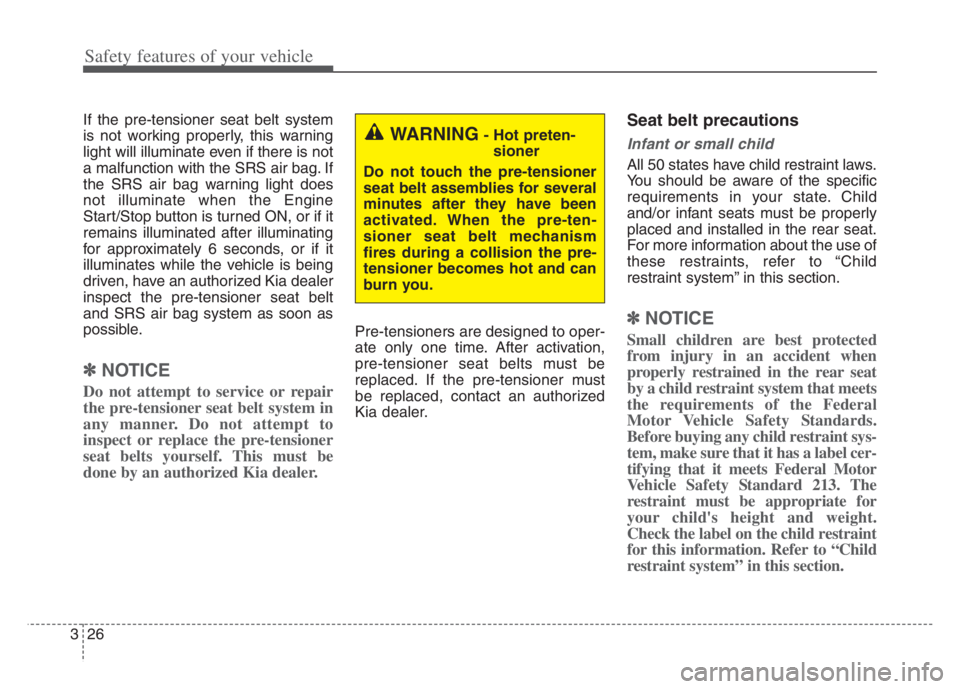
Safety features of your vehicle
26 3
If the pre-tensioner seat belt system
is not working properly, this warning
light will illuminate even if there is not
a malfunction with the SRS air bag. If
the SRS air bag warning light does
not illuminate when the Engine
Start/Stop button is turned ON, or if it
remains illuminated after illuminating
for approximately 6 seconds, or if it
illuminates while the vehicle is being
driven, have an authorized Kia dealer
inspect the pre-tensioner seat belt
and SRS air bag system as soon as
possible.
✽ ✽
NOTICE
Do not attempt to service or repair
the pre-tensioner seat belt system in
any manner. Do not attempt to
inspect or replace the pre-tensioner
seat belts yourself. This must be
done by an authorized Kia dealer.
Pre-tensioners are designed to oper-
ate only one time. After activation,
pre-tensioner seat belts must be
replaced. If the pre-tensioner must
be replaced, contact an authorized
Kia dealer.
Seat belt precautions
Infant or small child
All 50 states have child restraint laws.
You should be aware of the specific
requirements in your state. Child
and/or infant seats must be properly
placed and installed in the rear seat.
For more information about the use of
these restraints, refer to “Child
restraint system” in this section.
✽ ✽
NOTICE
Small children are best protected
from injury in an accident when
properly restrained in the rear seat
by a child restraint system that meets
the requirements of the Federal
Motor Vehicle Safety Standards.
Before buying any child restraint sys-
tem, make sure that it has a label cer-
tifying that it meets Federal Motor
Vehicle Safety Standard 213. The
restraint must be appropriate for
your child's height and weight.
Check the label on the child restraint
for this information. Refer to “Child
restraint system” in this section.
WARNING- Hot preten-
sioner
Do not touch the pre-tensioner
seat belt assemblies for several
minutes after they have been
activated. When the pre-ten-
sioner seat belt mechanism
fires during a collision the pre-
tensioner becomes hot and can
burn you.
Page 57 of 560
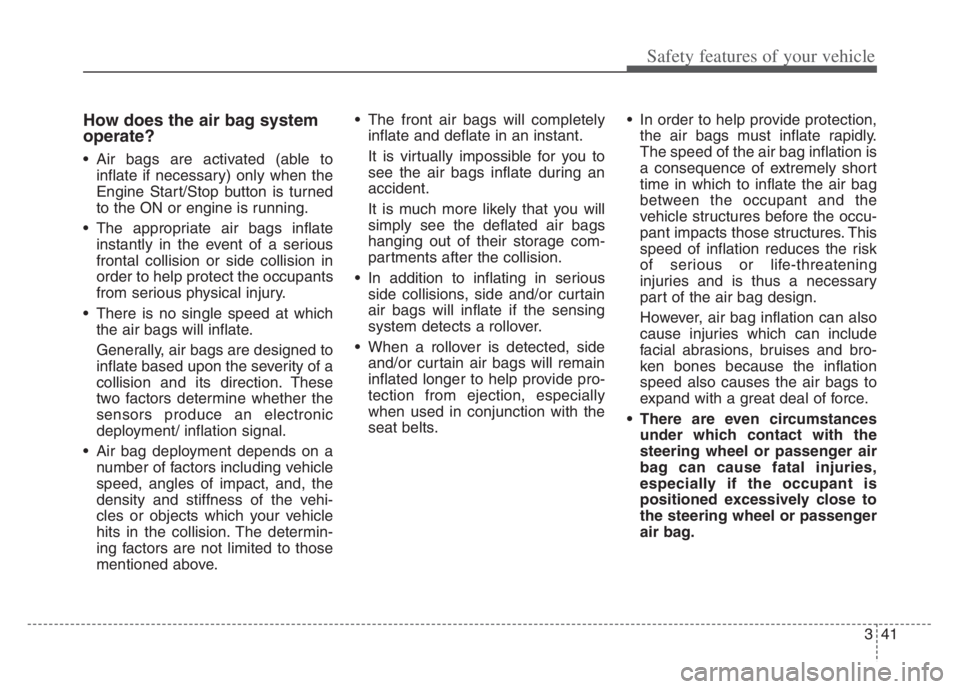
341
Safety features of your vehicle
How does the air bag system
operate?
Air bags are activated (able to
inflate if necessary) only when the
Engine Start/Stop button is turned
to the ON or engine is running.
The appropriate air bags inflate
instantly in the event of a serious
frontal collision or side collision in
order to help protect the occupants
from serious physical injury.
There is no single speed at which
the air bags will inflate.
Generally, air bags are designed to
inflate based upon the severity of a
collision and its direction. These
two factors determine whether the
sensors produce an electronic
deployment/ inflation signal.
Air bag deployment depends on a
number of factors including vehicle
speed, angles of impact, and, the
density and stiffness of the vehi-
cles or objects which your vehicle
hits in the collision. The determin-
ing factors are not limited to those
mentioned above. The front air bags will completely
inflate and deflate in an instant.
It is virtually impossible for you to
see the air bags inflate during an
accident.
It is much more likely that you will
simply see the deflated air bags
hanging out of their storage com-
partments after the collision.
In addition to inflating in serious
side collisions, side and/or curtain
air bags will inflate if the sensing
system detects a rollover.
When a rollover is detected, side
and/or curtain air bags will remain
inflated longer to help provide pro-
tection from ejection, especially
when used in conjunction with the
seat belts. In order to help provide protection,
the air bags must inflate rapidly.
The speed of the air bag inflation is
a consequence of extremely short
time in which to inflate the air bag
between the occupant and the
vehicle structures before the occu-
pant impacts those structures. This
speed of inflation reduces the risk
of serious or life-threatening
injuries and is thus a necessary
part of the air bag design.
However, air bag inflation can also
cause injuries which can include
facial abrasions, bruises and bro-
ken bones because the inflation
speed also causes the air bags to
expand with a great deal of force.
There are even circumstances
under which contact with the
steering wheel or passenger air
bag can cause fatal injuries,
especially if the occupant is
positioned excessively close to
the steering wheel or passenger
air bag.
Page 60 of 560
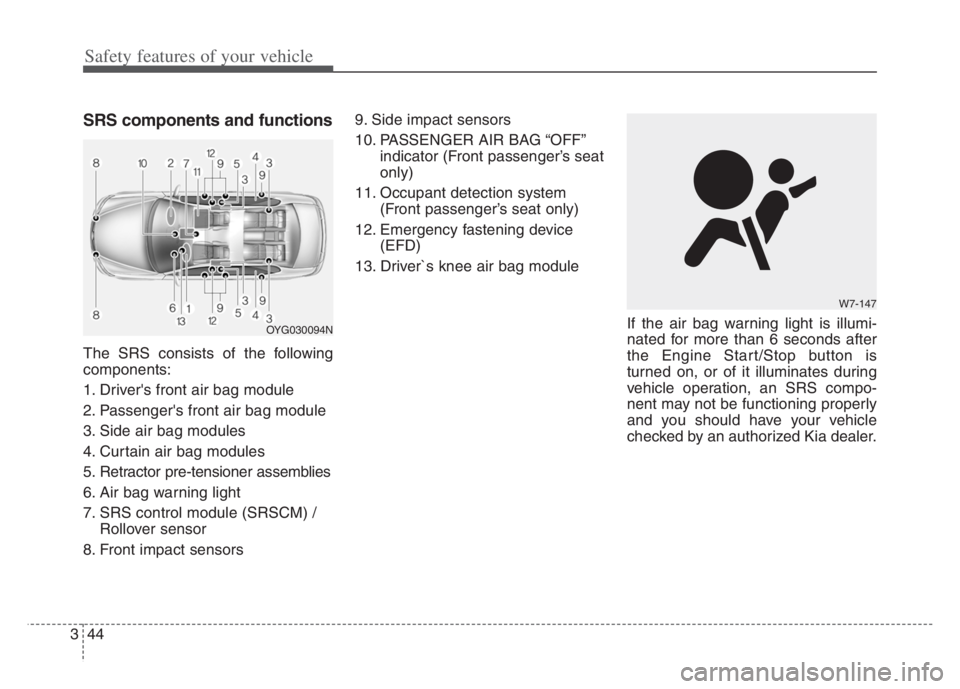
Safety features of your vehicle
44 3
SRS components and functions
The SRS consists of the following
components:
1. Driver's front air bag module
2. Passenger's front air bag module
3. Side air bag modules
4. Curtain air bag modules
5. Retractor pre-tensioner assemblies
6. Air bag warning light
7. SRS control module (SRSCM) /
Rollover sensor
8. Front impact sensors9. Side impact sensors
10. PASSENGER AIR BAG “OFF”
indicator (Front passenger’s seat
only)
11. Occupant detection system
(Front passenger’s seat only)
12. Emergency fastening device
(EFD)
13. Driver`s knee air bag module
If the air bag warning light is illumi-
nated for more than 6 seconds after
the Engine Start/Stop button is
turned on, or of it illuminates during
vehicle operation, an SRS compo-
nent may not be functioning properly
and you should have your vehicle
checked by an authorized Kia dealer.
W7-147
OYG030094N
Page 61 of 560
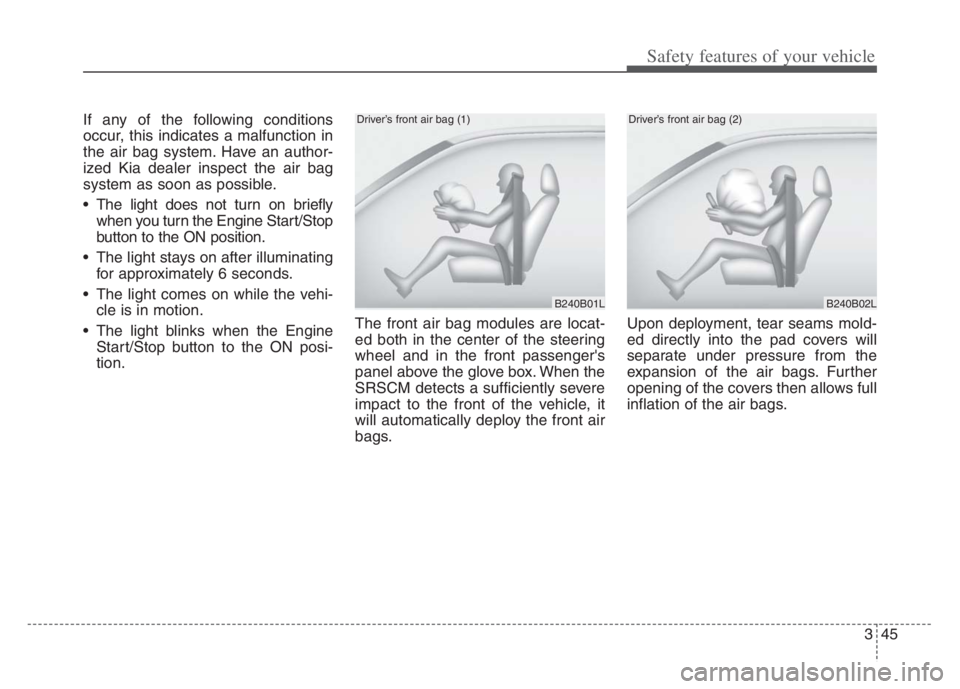
345
Safety features of your vehicle
If any of the following conditions
occur, this indicates a malfunction in
the air bag system. Have an author-
ized Kia dealer inspect the air bag
system as soon as possible.
The light does not turn on briefly
when you turn the Engine Start/Stop
button to the ON position.
The light stays on after illuminating
for approximately 6 seconds.
The light comes on while the vehi-
cle is in motion.
The light blinks when the Engine
Start/Stop button to the ON posi-
tion.The front air bag modules are locat-
ed both in the center of the steering
wheel and in the front passenger's
panel above the glove box. When the
SRSCM detects a sufficiently severe
impact to the front of the vehicle, it
will automatically deploy the front air
bags.Upon deployment, tear seams mold-
ed directly into the pad covers will
separate under pressure from the
expansion of the air bags. Further
opening of the covers then allows full
inflation of the air bags.
B240B01L
Driver’s front air bag (1)
B240B02L
Driver’s front air bag (2)